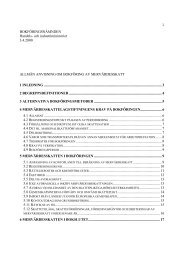Knowledge Intensive Services' Suppliers and Clients
Knowledge Intensive Services' Suppliers and Clients
Knowledge Intensive Services' Suppliers and Clients
Create successful ePaper yourself
Turn your PDF publications into a flip-book with our unique Google optimized e-Paper software.
19<br />
before <strong>and</strong> after they produce <strong>and</strong> sell the products. 6 Thus, Mathé <strong>and</strong> Shapiro<br />
(1993) cite studies indicating the important role of service elements in<br />
manufacturing (especially of high-tech products). For example, one survey of field<br />
service managers in high-tech equipment firms found that service quality scored<br />
highest among customer concerns. (The next most important attribute was<br />
reputation, followed by product quality.) Another survey found that German<br />
mangers considered that the competitive significance of service elements was<br />
growing <strong>and</strong> would exp<strong>and</strong> substantially over the next 10 years. They also cite case<br />
studies, such as the example of how Dutch flower-growers gained advantage over<br />
French competitors by having analysed delivery constraints <strong>and</strong> developed<br />
innovations to overcome these. (The innovations included: computerised ordertaking,<br />
grouped orders, organisation of delivery itineraries <strong>and</strong> use of shop keys to<br />
enter the shops <strong>and</strong> deposit the flowers before opening.) They also offered new<br />
services (ready-to-sell bunching at the flower “factory”) <strong>and</strong> they guaranteed stable<br />
prices.<br />
The argument about the growing role of services applies equally well to KISAs –<br />
indeed, many of the examples cited are cases of knowledge-intensive activities.<br />
The suggestion is that firms in all sectors, including manufacturers, are increasingly<br />
deriving competitive advantage from knowledge-intensive service processes<br />
associated with their core activities (be these service or material production).<br />
Somehow the knowledge-intensive activities are leading to greater demonstrable<br />
value for the customer. 7 This, of course, is the argument about the coming of the<br />
knowledge-based economy.The growth of KIBS is often taken as one major<br />
manifestation of this new, emerging, socioeconomic formation.<br />
6 Chase & Garvin (1989).<br />
7 This is based on the formulation set out by Quinn et al (op cit). For a lengthy exposition of “The<br />
Service Edge”, focusing on customer service in 101 US companies – including both manufacturing<br />
<strong>and</strong> service firms – see R Zemke (1990).
















